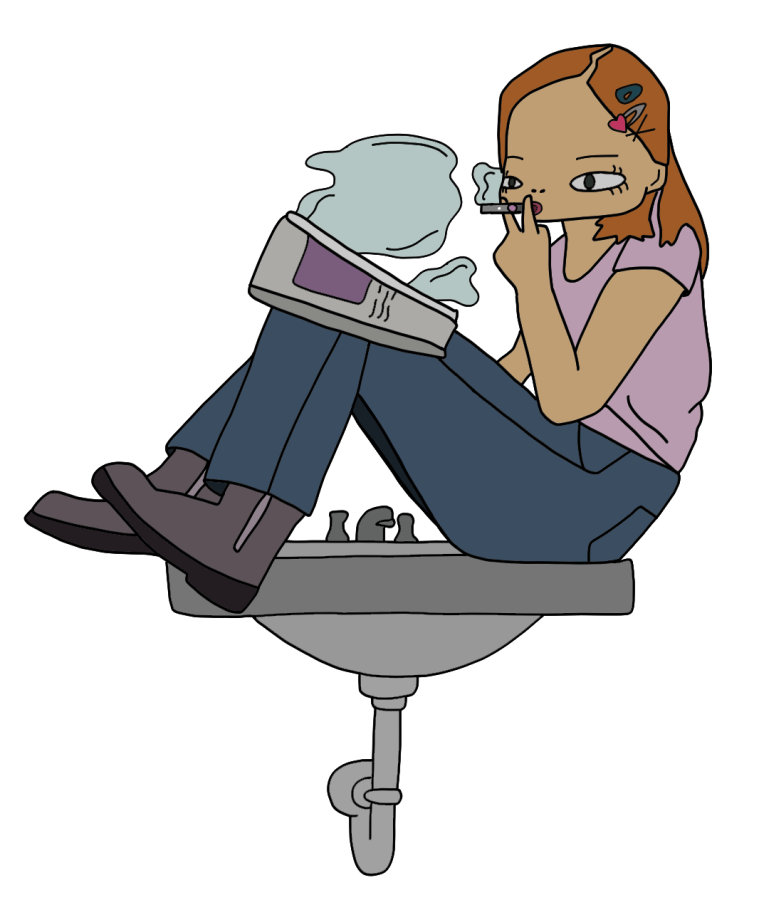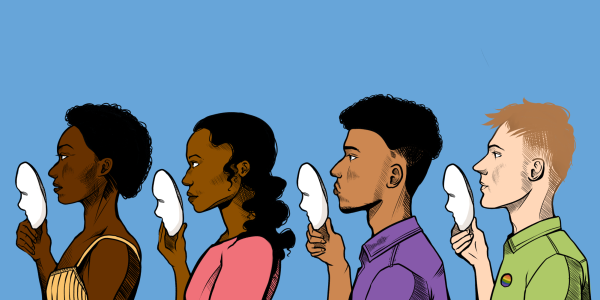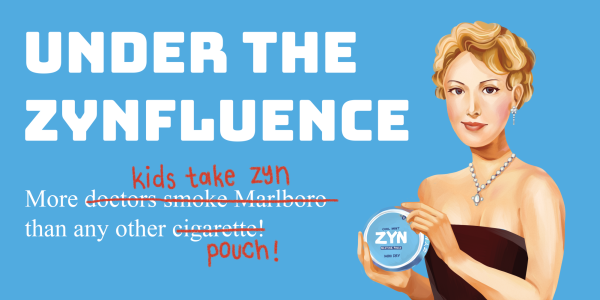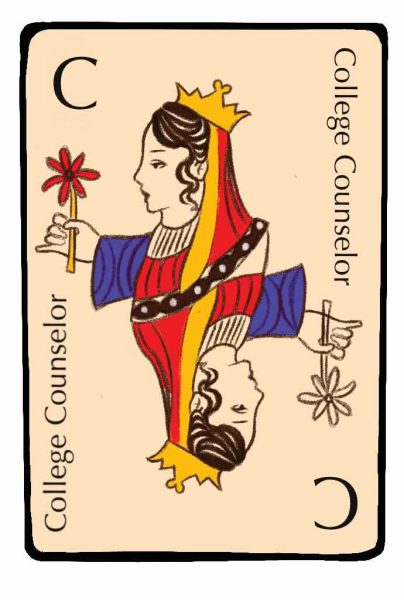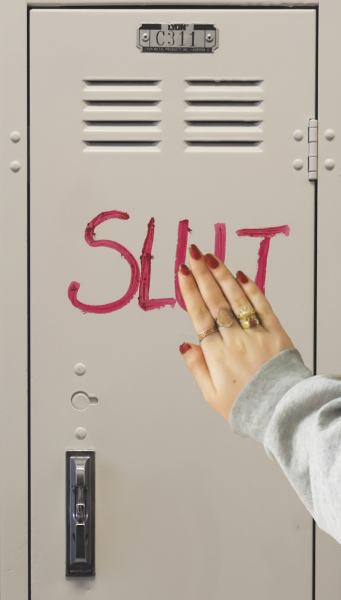“High” School
Community members discuss stoner culture and narcotic usage among students both in and out of the school.
A cartoon student sits on top of a sink while smoking.
March 24, 2022
Three girls cram behind the door of the far bathroom stall. Lillian* can feel her shoulders rubbing against her friends, breathing quickly as they shuffle their feet uncomfortably. Their eyes are fixed on the small red and green pouch they took from Lillian’s backpack just moments ago. Taking a nervous inhale, Lillian tugs at the silver zipper running through the colorful sack, revealing the Stiiizy, a THC vape pen, she brought from home. Just as she reaches to take a hit, the bathroom door opens and the shuffling stops. Lillian’s friends’ eyes break away from the pouch and turn towards her, panicked. But Lillian does not worry. It is just a passing student, and after a few calming murmurs, she inhales again, this time with the device pressed against her lips. Smoke crawls over the stall door as Lillian passes the Stiiizy to her left.
Frequent marijuana user discusses the drug in relation to her academic life
Lillian said she chose to partake in smoking during the school day on a whim, having initially brought her Stiizy for a friend.
“There wasn’t any particular reason [for smoking],” Lillian said. “I had an art class next block], and it was just convenient. [It was] easy.”
Lillian said although she has been advised against frequent marijuana usage, she still chooses to make the drug part of her daily routine.
“When I started smoking, people told me to keep it a weekend activity,” Lillian said. “But with [school], giving so much work and adding a lot of stress with tests, sometimes I [want to] relax for a second. It’s like an escape.”
Lillian said her smoking habits fluctuate from day to day based on her mood and that her mental health plays into whether or not she smokes on any given weekday. Nonetheless, she said she smokes marijuana four to five times a week.
“I’ve gone through periods of smoking every day, and I’ve gone through periods taking two-week breaks,” Lillian said. “I have considered smoking during the break of an academic class if I’ve been super anxious or in a bad mood.”
According to The Diagnostic and Statistical Manual of Mental Disorders (DSM-5) Fifth Edition website, the periodic use of cannabis can negatively affect an individual’s behavior in educational and work environments. The drug can cause physical changes and decrease one’s ability to complete basic tasks.
Lillian said in her experience using marijuana has not affected her academic performance.
“[My friends] have told me [that] it actually surprises them that I take all these [rigorous] classes because I smoke,” Lilian said. “I don’t think it really affects my academic life.”
Lillian said her habits are moderate compared to the usage of other weed users who smoke at an extreme level.
“I’m able to witness firsthand just how much [some people] smoke,” Lillian said “It’s like, ‘Oh, I smoke once at school.’ That’s not so bad. They’re literally smoking every single day, all day, every day.”
Lillian said though the at-school drug-using community is small, they are hard set in their ways.
“It’s a select group of people, maybe it’s like a handful of kids, but everybody I know who smokes at school does not want to stop and does not have any intention of stopping,” Lillian said.
Non-marijuana users reflect on the drugs’ role in the school community and culture
Miles Misczynski ’23 said though he does not share Lilian’s smoking habits, he has observed the same community of heavy marijuana users at school.
“I was in the bathroom, and I heard two kids’ voices come in [which] I recognized,” Misczynski said. “I knew what they were coming into the bathroom to do. They started [smoking] and laughing. They didn’t see me and left, and the whole bathroom [smelled of marijuana].”
Misczynski said he had predicted the students’ illicit activity based on the way they choose to dress and conduct themselves daily.
“[The assumption] came from their actions, what they talk about [and] how they act,” Misczynski said. “They like to embrace that sort of culture. They like to portray themselves as ‘stoner kids.’”
Misczynski said this stereotype is often propagated in modern media as a way to escape the tribulations of everyday life.
“I feel like throughout our [society] and [platforms] like TikTok there’s sort of style or fashion [that] has been developed to what a stoner kid should look like,” Misczynski said. “I think a bunch of kids feel like they have to resort to it. They feel safe being in that community.”
Olivia Rahhal ’23 said there is a common aesthetic shared by marijuana users.
“When I think of a ‘stoner’ I picture baggy clothes [and] earth tones,” Rahhal said. “Basically grunge chic with messy hair, that kind of thing.”
Rahhal said, despite her decision not to smoke weed, she generally views smoking as a fun and relatively harmless way to relieve stress, whether in or out of school.
“I think ‘stoners’ get a pretty bad [reputation],” Rahhal said. “I don’t think there’s anything really inherently wrong with it. You’re doing it for fun and to relax. It’s not really hurting anyone. I don’t think that doing it at school or at a place that you’re not supposed to really signals to me an immediate need for like punishment.”
Misczynski, on the other hand, said he has avoided this lifestyle due to the negative effects that may come from a dependency on marijuana.
“Obviously, [there are] health implications and it could also just cause educational troubles,” Misczynski said. “If your priorities when you’re at school aren’t actually school, you could [have problems] later down in life.”
Stefan*, who uses marijuana daily, said potential negative effects do not prevent him from using it. On the contrary, he said he does not think he smokes enough.
“Am I high every day at school? No. Should I be? Yes,” Stefan said. “I guess I have to function a little bit, but if I could be high 24/7, I would [be].”
Users discuss how the school has affected and reacted to narcotic use
Stefan said he began moderately smoking at a young age, but he said his usage eventually grew into a consistent habit.
“I was 12 [when I first smoked] weed,” Stefan said. “It was like a one-time thing, and then I did it again when I was 13. I [then] started to get high and see movies at [Westfield Century City], and then it grew into me taking an edible every day before school.”
Stefan said his early start with marijuana helped him to develop a healthy relationship with the drug, even if smoking has harmed other connections in his life.
“[Weed] has ended relationships of mine for sure, because I’d rather choose [weed] over [other things],” Stefan said. “But I have grown through ups and downs of dependency, and now, I know how to balance myself way better than I did.”
Stefan said his marijuana usage is partly a response to the school’s intense academic and social cultures, which he said he feels disconnected from. He said drugs have allowed him to explore aspects of himself again, which demands of school have prevented him from enjoying.
“I learned fast [that] I was not a traditional Harvard-Westlake kid,” Stefan said. “Kids here stay very sheltered in their bubbles.”
Stefan said using drugs has allowed him to break out of the confinements the school places upon him.
“I feel like drugs have allowed me to experience what the school has kept me so closed off to,” Stefan said. “I like the underground sh*t, like downtown Los Angeles (LA), how many kids here do you think f**k with downtown LA?”
Stefan said he finds his approach to school completely acceptable and said it is far less harmful to other students than ways some students handle their academic stress.
“You’ve got to play the system because it’s all a game,” Stefan said. “It’s kind of messed up how kids cheat the system. That’s how they get good grades you know, with how the curriculum is built: Cheating. I don’t like to cheat. So I’d rather get high and just pass.”
The school has punished students for partaking in substances on campus. One such case is current Viewpoint School senior Jack Conlin, who was asked to leave Harvard-Westlake as a ninth grader after he was caught using nicotine products in the middle school bathrooms.
Conlin said the school’s “punish-first” approach was an inappropriate response to his actions, and he said there are far more helpful alternatives.
“I think the way the school handled it was extreme and considering their job is to educate, [but] they didn’t really do that,” Conlin said. “My new school had me take a Stanford [University] online class to better understand the harms of vaping, which I learned a lot from. I needed to learn not to be aimlessly punished, but the school didn’t really see that.”
Members of administration explain their approach to narcotic use at the school as well as its history at the school
President Rick Commons said punishment is a secondary factor in maintaining a healthy and safe environment at the school.
“Our desire is to keep people healthy, and we know that tobacco products are unhealthy,” Commons said. “It’s not just a desire, but it’s a promise that we’ve made to families to do everything we can to make the environment and student wellness healthy. Our student disciplinary policy is not because we want to exact price for misdeeds. It is designed to preserve the environment of health and to disincentive the use of [unhealthy] tobacco products among [the student body].”
Commons said although he can understand the impulse to relieve the pressure the school might place upon students, his goal is to offer more positive methods of relief than smoking or vaping.
“We know that stress is a challenge in our intense environment,” Commons said. “I can imagine that a student might feel the need to relieve stress in that way. Our aim to help students to relieve stress in healthy ways through exercise, through meditation, through laughter with friends, through getting more sleep or through talking with a counselor, not through turning to substances that make a person less healthy.”
Upper School Counselor Michelle Bracken said she agrees with the school’s policy that students should be disciplined for such actions but thinks it needs to better explain the consequences of consuming drugs and alcohol.
“I think the protocol for the school needs to be communicated to students in the same way that sexual harassment or consent or any of those things [happen],” Bracken said. “I think education needs to be about communication, what the procedure is and why it’s set up the way that it is. The goal is to help someone and not to be punitive.”
Bracken said in the past students have met with her to discuss concerns on their peers’ addictions but have been worried about outing them.
“These are sticky situations,” Bracken said. “No student wants to come forward and talk about their friend [revealing] details or information [and being] the one [outing] that friend. At the same time, if we don’t know who that friend is, we can’t help them.”
Bracken said the school has dealt with these situations in the past and is aware of students partaking drugs and alcohol at school. She said students at the Upper School have been punished for participating in drug-related activities on campus.
“Every school is dealing with the idea that kids smoke weed or drink during the day,” Bracken said. “[Around] 15 years ago, [there was a student] selling drugs on campus. [She] got kicked out in May [of her] senior year and her life was turned upside down. She was an addict and her [and] us doing that saved her life.”
Bracken said in the past, the consequences of students becoming addicted at a young age have included attending rehabilitation centers.
“There have been [students] whose parents have sent [rehabilitation workers] to pick up their kid at school [and] take the kid to rehabilitation somewhere in Arizona or something. These things don’t happen a lot, but they do happen.”































